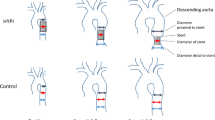Summary
This study was aimed to establish a stable animal model of left ventricular hypertrophy (LVH) to provide theoretical and experimental basis for understanding the development of LVH. The abdominal aorta of male Wistar rats (80–100 g) was constricted to a diameter of 0.55 mm between the branches of the celiac and anterior mesenteric arteries. Echocardiography using a linear phased array probe was performed as well as pathological examination and plasma B-type natriuretic peptide (BNP) measurement at 3, 4 and 6 weeks after abdominal aortic constriction (AAC). The results showed that the acute mortality rate (within 24 h) of this modified rat model was 8%. Animals who underwent AAC demonstrated significantly increased interventricular septal (IVS), LV posterior wall (LVPWd), LV mass index (LVMI), cross-sectional area (CSA) of myocytes, and perivascular fibrosis; the ejection fraction (EF), fractional shortening (FS), and cardiac output (CO) were consistently lower at each time point after AAC. Notably, differences in these parameters between AAC group and sham group were significant by 3 weeks and reached peaks at 4th week. Following AAC, the plasma BNP was gradually elevated compared with the sham group at 3rd and 6th week. It was concluded that this modified AAC model can develop LVH, both stably and safely, by week four post-surgery; echocardiography is able to assess changes in chamber dimensions and systolic properties accurately in rats with LVH.
Similar content being viewed by others
References
Boluyt MO, Robinson KG, Meredith AL, et al. Heart failure after long-term supravalvular aortic constriction in rats. Am J Hypertens, 2005,18(2 Pt 1):202–212
Molina EJ, Gupta D, Palma J, et al. Novel experimental model of pressure overload hypertrophy in rats. J Surg Res, 2009,153(2):287–294
Cantor EJ, Babick AP, Vasanji Z, et al. A comparative serial echocardiographic analysis of cardiac structure and function in rats subjected to pressure or volume overload. J Mol Cell Cardiol, 2005,38(5):777–786
Xu R, Lin F, Zhang S, et al. Signal pathways involved in reverse remodeling of the hypertrophic rat heart after pressure unloading. Int J Cardiol, 2010,143(3):414–423
Kompa AR, Wang BH, Phrommintikul A, et al. Chronic urotensin II receptor antagonist treatment does not alter hypertrophy or fibrosis in a rat model of pressure-overload hypertrophy. Peptides, 2010,31(8):1523–1530
Shah KB, Duda MK, O’Shea KM, et al. The cardioprotective effects of fish oil during pressure overload are blocked by high fat intake: role of cardiac phospholipid remodeling. Hypertension, 2009,54(3):605–611
Kokubo M, Uemura A, Matsubara T, et al. Noninvasive evaluation of the time course of change in cardiac function in spontaneously hypertensive rats by echocardiography. Hypertens Res, 2005,28(7):601–609
Pandey KN. Biology of natriuretic peptides and their receptors. Peptides, 2005,26(6):901–932
Gu J, D’Andrea M, Seethapathy M, et al. Physical overdistension converts ventricular cardiomyocytes to acquire endocrine property and regulate ventricular atrial natriuretic peptide production. Angiology, 1991,42(3):173–186
Phrommintikul A, Tran L, Kompa A, et al. Effects of a Rho kinase inhibitor on pressure overload induced cardiac hypertrophy and associated diastolic dysfunction. Am J Physiol Heart Circ Physiol, 2008,294(4):H1804–H1814
Ono K, Masuyama T, Yamamoto K, et al. Echo doppler assessment of left ventricular function in rats with hypertensive hypertrophy. J Am Soc Echocardiogr, 2002,15(2): 109–117
Sahn DJ, DeMaria A, Kisslo J, et al. Recommendations regarding quantitation in M-mode echocardiography: results of a survey of echocardiographic measurements. Circulation, 1978,58(6):1072–1083
Doser TA, Turdi S, Thomas DP, et al. Transgenic overexpression of aldehyde dehydrogenase-2 rescues chronic alcohol intake-induced myocardial hypertrophy and contractile dysfunction. Circulation, 2009,119(14):1941–1949
Shen YT, Malik FI, Zhao X, et al. Improvement of cardiac function by a cardiac Myosin activator in conscious dogs with systolic heart failure. Circ Heart Fail, 2010,3(4):522–527
Nader L, Lahoud L, Chouery E, et al. B-type natriuretic peptide receptors in hypertrophied adult rat cardiomyocytes. Ann Cardiol Angeiol (Paris), 2010,59(1): 20–24
Ruetten H, Dimmeler S, Gehring D, et al. Concentric left ventricular remodeling in endothelial nitric oxide synthaseknockout mice by chronic pressure overload. Cardiovasc Res, 2005,66(3):444–453
Heyen JR, Blasi ER, Nikula K, et al. Structural, functional, and molecular characterization of the SHHF model of heartfailure. Am J Physiol Heart Circ Physiol, 2002, 283(5):H1775–H1784
Namba T, Tsutsui H, Tagawa H, et al. Regulation of fibrillar collagen gene expression and protein accumulation involume-overloaded cardiac hypertrophy. Circulation, 1997,95(10):2448–2454
Beeri R, Chaput M, Guerrero JL, et al. Gene delivery of sarcoplasmic reticulum calcium ATPase inhibits ventricularremodeling in ischemic mitral regurgitation. Circ Heart Fail, 2010,3(5):627–634
Yoon PO, Lee MA, Cha H, et al. The opposing effects of CCN2 and CCN5 on the development of cardiac hypertrophyand fibrosis. J Mol Cell Cardiol, 2010,49(2): 294–303
Nader L, Smayra V, Jebara V, et al. Brain natriuretic peptide secretion in adult rat heart muscle cells: the role of calcium channels. Arch Cardiovasc Dis, 2008,101(7–8):459–463
Author information
Authors and Affiliations
Corresponding author
Additional information
Both authors contributed equally to this work.
This project was supported by grants from the National Natural Science Foundation of China (No. 30440053), the Natural Science Foundation of Guangdong Province (Nos. S2011010004269 and 9151018201000029) and the PhD Start-up Fund of Guangzhou Medical University (No. 2012C57).
Rights and permissions
About this article
Cite this article
Dai, Wj., Dong, Q., Chen, Ms. et al. Alterations in cardiac structure and function in a modified rat model of myocardial hypertrophy. J. Huazhong Univ. Sci. Technol. [Med. Sci.] 34, 626–633 (2014). https://doi.org/10.1007/s11596-014-1328-7
Received:
Revised:
Published:
Issue Date:
DOI: https://doi.org/10.1007/s11596-014-1328-7




